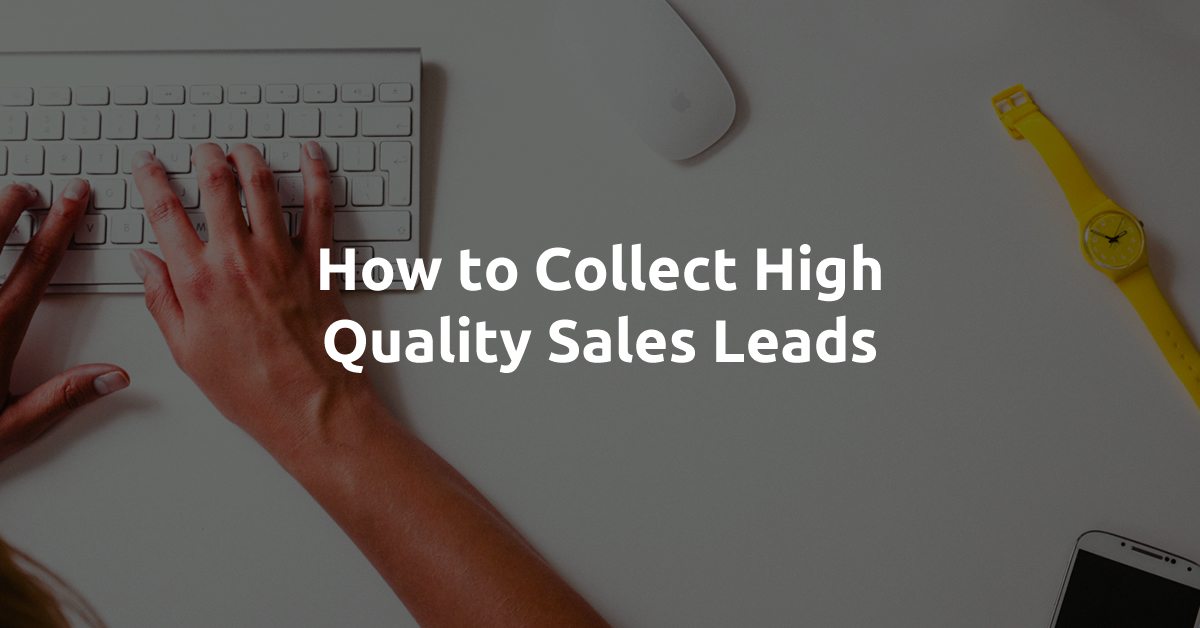Collecting sales leads can be difficult; collecting high quality sales leads can feel impossible.
Figuring out how to collect high quality leads is perhaps the biggest win that a B2B company can make on the marketing front since it makes the job of the sales team much easier when leads are actually qualified.
We’ve spent time studying dozens of philosophies on generating, nurturing, and managing leads. What we’ve learned all revolves around the notion that marketing and sales teams need to spend more time working together on defining what exactly a quality lead is for their organization.
We’ve summarized some of the key things that we’ve learned into the following tips on how to collect high quality sales leads.
3 Tips on How to Collect High Quality Sales Leads
1. Make Sales and Marketing Teams Collaborate
If your sales and marketing teams are not on the same page, it’s going to be virtually impossible to collect high quality sales leads.
The task of making these two teams agree on things may feel somewhat daunting, but it’s absolutely essential.
Because of the essentialness of making sales and marketing teams collaborate, it’s both important for new companies and old companies to think about if they are properly doing this.
You want to bring the two teams together to define what exactly a sales lead is and what makes a good sales lead for your company. When the two teams have come up with a definition that they agree on, it becomes much easier to focus on getting more leads that will ultimately convert.
Making the two teams work together also means that more people have a part in making the definition of a high quality sales lead together. This translates into more people feeling personally responsible for collecting more high quality leads. If people feel like they are part of the internal definition of a high quality sales lead, they will be happier working on collecting more leads and be more motivated.
2. Ask a Ton of Questions
To collect more high quality sales leads, it’s vital that you to ask a ton of questions about the leads that you want. This ties in seamlessly to our first tip on making sales and marketing teams collaborate.
When the two teams are working together on defining what a high quality sales lead is, they should be asking questions such as the following:
How long does it currently take us to close a sale?
How can we shorten the amount of time it takes to close a sale?
Why do leads that don’t convert fall out of the sales funnel?
Why do leads that convert end up converting?
Which leads converted fastest? Why?
You can surely think of additional questions to ask, but we think that those 5 questions will be a great starting point.
3. What Problem Does Your Lead Have?
Taking some time to consider the problems your leads face will help you make more compelling sales copy that ends up collecting higher quality leads. When you understand the challenges facing your leads, you can find openings to capture them while they are researching a solution and introduce them to your product or service.
When you’re outlining the problem your leads are trying to solve, you’re going to have to craft messaging for three types of prospects that you want to intercept:
Continuing education: These leads are already extremely knowledgeable, but they want to learn more about their industry and are researching tools that can help them further their knowledge.
Looking for new information: These prospects have just started researching how to solve their problem, and don’t yet know much. If you can intercept these people on their quest for knowledge, you’ll have a decent chance at converting them fast because they’ll most likely view your brand as extremely trustworthy if they learn about you early on.
Opportunity seekers: This type of buyer isn’t very price sensitive and is keen to purchase a product that will immediately solve their problem. You need to focus on ways to quickly assure them that they’re making the right decision and then quickly funnel them into your sales flow since they’re willing to convert fast.
Experimentation Matters
If you don’t experiment like crazy, you won’t collect high quality leads. Experimentation matters because the process of lead generation is constantly changing. You need to have an agile mindset, constantly keep track of your industry, and examine how competitors are successfully (or unsuccessfully) collecting leads.
Experimentation on lead generation also doesn’t mean just testing out how to collect new leads, but also examining how current customers are interacting with your product or service. To do this, we recommend using a tool like Mixpanel. Mixpanel makes it easy to learn how people use your product with advanced, yet easy to understand, mobile and web analytics.
If you experiment like crazy, understand how converted users are using your product to solve their problems, and get the sales and marketing teams to work together, you’re going to collect high quality sales leads.
Bonus: AeroLeads
AeroLeads allow you to find all the details of the prospect, either business or a person like name, email, contact person name, social Media Accounts etc. The prospect and contact details can be transferred to Mailchimp, Pipedrive, SalesForce and HubSpot. Click here to try AeroLeads for free.
Bonus: LeadBoxer
Collecting high quality leads is much easier to do when you use a tool like LeadBoxer. LeadBoxer allows you to collect leads without using any forms or buttons. When you add the LeadBoxer snippet to your site, it will reveal who is visiting you, what products they are interested in, and then gives them a score so you understand the quality of a lead. Click here to try LeadBoxer for free.
